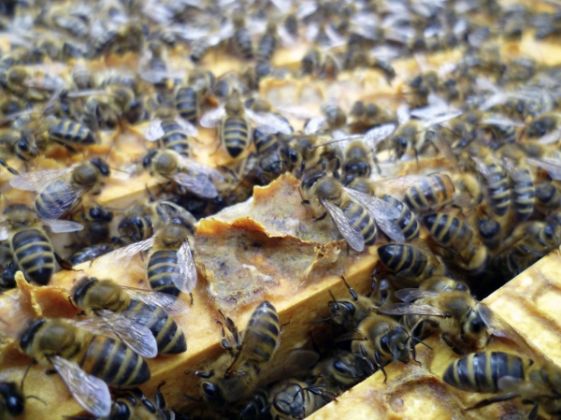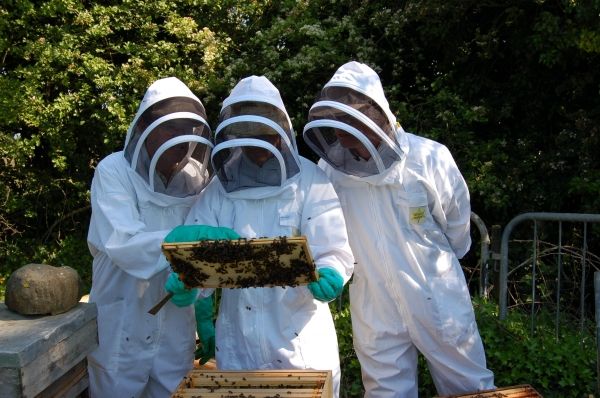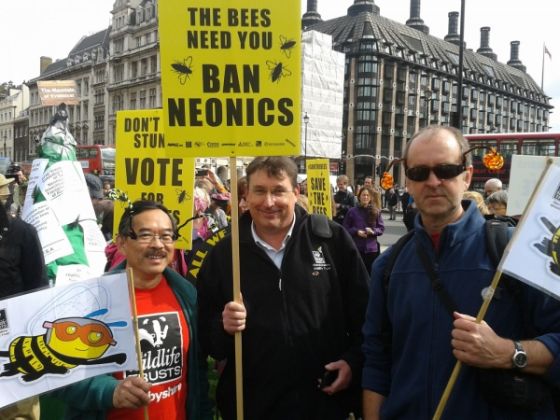Bees for British Expo 2015
The British pavilion in Milan will focus on the importance of the honey bee to our planet
British beekeepers will be delighted by the news that the winning design for the British pavilion at Milan's Expo 2015 designed by Wolfgang Buttress (see Side Notes below) is inspired by the life and “unique role of the honey bee”.
Visitors to the British pavilion in Milan next year will be greeted by fruit trees, will linger in the courtyard, stroll through an undulating meadow and then take several winding routes to the “hive”. The visit is accompanied by the hum of bees and visual reminders of the hive such as honeycomb designs along the way.
It is sad that British lovers of honey and beekeepers get less and less opportunity to hear the buzz of bees, let alone appreciate the work of the honey bee, the apis mellifera. The country's bee colonies are in sharp decline.
Some of the blame for the precarious state of British bees (but certainly not all of it) can be put down to a wet spring in 2013, to maurading hornets (coming from “abroad” ) and to the infamous varroa mite that leeches on bees and eventually kills them. But most beekeepers know that the steep decline of colonies of both honey and bumble bees (which in some cases are more efficient pollinators than the honey bee) means that something else is killing British bees.
About two seasons ago I watched a hive of bees disappear in the UK. And when I say “disappear” I mean vanish, not die. I noticed unusual behaviour for several weeks. The bees were no longer able to calculate the height of the entrance to the hive. Arriving home at speed and weighed down with pollen some would fly too high, hurtling against the supers (the upper part of the hive) and then crash to the ground. Others would arrive too low, missing the little platform in front of the hive entrance and tumble helplessly into the long grass below. Anyone who has kept bees knows that this is not normal behaviour.
Then one sunny morning I noticed no activity at all. When I opened the hive there wasn't a bee in sight, not even a corpse. It was like arriving at a once-bustling town to find that everyone had fled.
It was obvious from the empty state of the hive that the bees had not died from one of the bacterial diseases to which they are prone, such as American or the less-serious European foulbrood. They had not been attacked by the varroa mite, wax moth or raiding hornets. They had simply gone.
Although the scientific evidence is not yet conclusive beekeepers generally think that these little creatures are suffering from pesticides sprayed on neighbouring crops and gardens. Most pesticides now contain nerve-agents called neonicotinoids (or neonics for short) which, as the name suggests, contain nicotine-like chemicals.
The pharmaceutical companies that produce these pesticides claim that they do not kill bees because the doses sprayed on crops are not high enough to harm them. Maybe that is true but the new generation of nicotine-containing pesticides are designed to disorient insects. My bees were certainly disoriented.
There is enough evidence of the danger of neonicotinoids to have convinced 15 out of the 27 members of the European Union of the harm they are doing. As of 1 December last year clothianidin, imidacloprid and thiametoxam are out of bounds for a trial two-year period.
The ban is also in operation but the UK agreed to the regulation only after a great deal of grumbling from the department of environment, food and rural affairs. DEFRA (which was once the ministry of agriculture) did not like the EU’s decision, claiming that there was not enough scientific evidence to back up the ban.
To quote from its report:
“Our current assessment of the evidence is that there is not an unacceptable risk to pollinators from the present uses of neonicotinoids. We therefore regard sweeping restrictions on neonicotinoids as unnecessary and the resultant costs as unjustified.”
Its opposition was not enough to prevent the two-year ban on crops such as rape seed and maize but DEFRA has allowed gardeners and horticulturalists to continue using these toxins on their flowers and vegetables.
However the British supermarket chain Waitrose is taking a more positive approach. It has told its suppliers of fruit, vegetables and flowers to stop using neonicotinoids by the end of 2014 as a “responsible preliminary cautionary step”. Waitrose has said that it supports the EU ban and is funding a three-year research project at the University of Exeter to look into the effect on pollinators of a combination of these substances and other pesticides.
In Italy where spraying of neonicotinoids on maize crops was banned in 2008 after a disasterous summer when tens of thousands of bee hives were lost along the Po Valley, the follwing three seasons saw a considerable improvement in the well-being of bee populations, according to Unaapi (Unione Nazionale Associazioni Apicoltori Italiani which represents about 26 per cent of the more than one million Italian beekeepers). The banned was then extended for a fourth year and is now covered by the EU regulations.
In July last year the Unaapi magazine, Miele d’Italia, published a long list of the international research into the damaging effects of neonicotinoids on bees and the consequences for agriculture.
The battle continues over the reasons for declining honey-bee populations. Researchers on both sides claim that the work of the other side is faulty. Meanwhile the pharmaceutical companies that manufacture the neonicotinoids are delighted that so far there is no indisputable proof that that their products are harmful to bees. And farmers are also relieved that they don’t yet have to give up completely on a substance that keeps their “pests” under control.
The British Expo 2015 pavilion is therefore a hopeful new sign of a committment to the importance of bees to our ecosystem. Whatever the doubts of DEFRA on the research to date, the British pavilion at Expo 2015 is an indication that Britons really do understand that bees are fundamental not only to the production of crops, but also to feeding the planet and energy for life.*
Mary Wilsey
*The theme for Expo 2015.
Side Notes
Wolfgang Buttress is the designer of the British pavilion for Milan's Expo 2015. In his introduction explaining the inspiration behind his winning design Buttress points out that there is an intrinsic relationship between bees and humans. Not only do bees pollinate every third mouthful of food we consume, but the organisation of the hive and the complex interdependencies of the social structures within it are an advanced and complex ecosystem, with parallels in human culture. The hive acts as a sort of barometer of the world’s health and the present precarious state of the health of bees in the developed world is a serious sign for the planet.
There are four focal points to the pavilion; the orchard where visitors will be welcomed by British fruit trees; the meadow, which is an undulating green roof to the service areas of the pavilion (shops, gallery, office, plant room, bar and kitchen). From the meadow there are multiple pathways that reflect the orienting dance of the honey bee. These eventually lead to the hive, a sphere that could represent an atom, the planet, the sun or a grain of pollen. Its structural design will be one of the most inventive parts of the pavilion, using a variety of new and sophisticated materials and geometrical shapes that mirror the inside of a hive. Once constructed it will be connected to a real hive via accelerometers that measure the bees’ vibrations and LED lights to reflect their movements as they work. There will also be a live video feed from the hive to be screened on a wall in the orchard.
The €6 million contract for construction has been awarded to two British companies, construction consultants Stage One, which is based in York and the London-based RISE, that specialises in temporary structures. Wolfgang Buttress has a small studio in Nottingham and earlier this year won the Kajima Gold Award in Japan for his work Space. The British minister of trade said the British pavilion “will promote the UK's world leading expertise in the creative, life sciences, agri-tech, food and drink sectors to our top trade and investment partners.” The winners were announced by Prince Harry during a visit to the MAXXI Museum of Contemporary Art in Rome on 18 May. Expo 2015 opens in Milan on 1 May 2015.
























